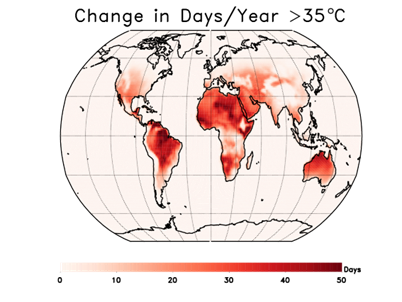WMO Bulletin: heatwaves worsen air quality and pollution
Climate change is increasing the intensity and frequency of heatwaves. This extreme heat, compounded by wildfires and desert dust, is having a measurable impact on air quality, human health and the environment, according to a new report from the World Meteorological Organization (WMO).

The 2023 WMO Air Quality and Climate Bulletin, the third in an annual series, puts the spotlight on heatwaves. This is to draw attention to the fact that it is not just high temperatures which are a hazard, but also the impacts of resulting pollution which are often overlooked but are just as pernicious.
It shows how heatwaves triggered wildfires in the northwestern United States and heatwaves accompanied by desert dust intrusions across Europe both led to dangerous air quality in 2022. It also includes case studies from Brazil on how parks and tree-covered areas within cities can improve air quality, absorb carbon dioxide and lower temperatures, thus benefiting inhabitants.
“Heatwaves worsen air quality, with knock-on effects on human health, ecosystems, agriculture and indeed our daily lives,” said WMO Secretary-General Prof. Petteri Taalas. “Climate change and air quality cannot be treated separately. They go hand-in-hand and must be tackled together to break this vicious cycle,” he said.
“This Air Quality and Climate Bulletin relates to 2022. What we are witnessing in 2023 is even more extreme. July was the hottest ever month on record, with intense heat in many parts of the northern hemisphere and this continued through August,” he said.
“Wildfires have roared through huge swathes of Canada, caused tragic devastation and death in Hawaii, and also inflicted major damage and casualties in the Mediterranean region. This has caused dangerous air quality levels for many millions of people, and sent plumes of smoke across the Atlantic and into the Arctic,” said Prof. Taalas.
Climate change is increasing the frequency and intensity of heatwaves, and this trend is expected to continue in the future. There is growing scientific consensus that heatwaves will increase the risk and severity of wildfires.
“Heatwaves and wildfires are closely linked. Smoke from wildfires contains a witch’s brew of chemicals that affects not only air quality and health, but also damages plants, ecosystems and crops – and leads to more carbon emissions and so more greenhouse gases in the atmosphere,” says Dr Lorenzo Labrador, a WMO scientific officer in the Global Atmosphere Watch network which compiled the Bulletin.
WMO released the report to coincide with the International Day of Clean Air for blue skies on 7 September. The theme this year is Together for Clean Air, focusing on the need for strong partnerships, increased investment and shared responsibility to overcome air pollution.


